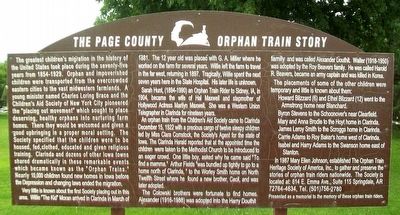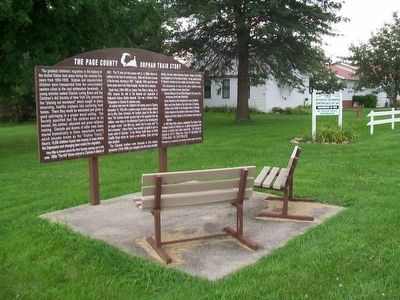The Page County Orphan Train Story
The greatest children's migration in the history of the United States took place during the seventy-five years from 1854-1929. Orphan and impoverished children were transported from the overcrowded eastern cities to the vast midwestern farmlands. A young minister named Charles Loring Brace and the Children's Aid Society of New York City pioneered the "placing out movement" which sought to place deserving, healthy orphans into nurturing farm homes. There they would be welcomed and given a good upbringing in a proper moral setting. The Society specified that the children were to be housed, fed, clothed, educated and given religious training. Clarinda and dozens of other Iowa towns shared dramatically in these remarkable events which became known as the "Orphan Trains." Nearly 10,000 children found new homes in Iowa before the Depression and changing laws ended the migration.
Very little is known about the first Society placing out in this area. Willie "The Kid" Moran arrived in Clarinda in March of 1881. The 12 year old was placed with G. A. Miller where he worked on the farm for several years. Willie left the farm to travel in the far west, returning in 1897. Tragically, Willie spent the next seven years here in the State Hospital. His later life is unknown.
Sarah Hunt, (1894-1990) an Orphan Train Rider to Sidney, IA, in 1904,
became the wife of Hal Maxwell and stepmother of Hollywood Actress Marilyn Maxwell. She was a Western Union Telegrapher in Clarinda for nineteen years.An orphan train from the Children's Aid Society came to Clarinda December 15, 1922 with a precious cargo of twelve sleepy children led by Miss Clara Comstock, the Society's Agent for the state of Iowa. The Clarinda Herald reported that at the appointed time the children were taken to the Methodist Church to be introduced to an eager crowd. One little boy, asked why he came said "To find a mamma." Arthur Fields "was bundled up tightly to go to a home north of Clarinda," to the Worley Smith home on North Twelfth Street where he found a new brother, Cecil, and was later adopted.
The Colowski brothers were fortunate to find homes. Alexander (1916-1988) was adopted into the Harry Douthit family and was called Alexander Douthit. Walter (1918-1950) was adopted by the Roy Beavers family. He was called Harold R. Beavers, became an army captain and was killed in Korea.
The placements of some of the other children were temporary and little is known about them:
Howard Blizzard (6) and Ethel Blizzard (12) went to the Armstrong home near Blanchard.
Byron Stevens to the Schoonover's near Clearfield.
Mary and Anna Brodie to the Hoyt home in Clarinda.
James Leroy Smith to the Scroggs home in Clarinda.
Carrie Adams
Isabel and Harry Adams to the Swanson home east of Stanton.
In 1987 Mary Ellen Johnson, established The Orphan Train Heritage Society of America, Inc., to gather and preserve the stories of orphan train riders nationwide. The Society is located at: 614 E. Emma Ave., Suite 115 Springdale, AR 72764-4634, Tel. (501) 756-2780
Presented as a memorial to the memory of these orphan train riders.
Topics. This historical marker is listed in this topic list: Charity & Public Work. A significant historical month for this entry is March 1881.
Location. 40° 43.331′ N, 95° 2.253′ W. Marker is in Clarinda, Iowa, in Page County. Marker is on 16th Street / Glenn Miller Avenue (U.S. 71) south of Essie Davison Drive, on the left when traveling south. Touch for map. Marker is at or near this postal address: 1600 South 16th Street, Clarinda IA 51632, United States of America. Touch for directions.
Other nearby markers. At least 8 other markers are within walking distance of this marker. Historical Goldenrod (a few steps from this marker); Mattie Lou Cavender (within shouting distance of this marker); Goldenrod School (within shouting distance of this marker); Jessie Field Shambaugh (within shouting distance of this marker); a different marker also named Jessie Field Shambaugh (within shouting distance of this marker); Clarinda Freedom Rock Veterans Memorial
More about this marker. Marker is on the grounds of the Nodaway Valley Historical Museum.
Related markers. Click here for a list of markers that are related to this marker.
Also see . . .
1. National Orphan Train Complex, Concordia, Kansas. (Submitted on September 2, 2015, by William Fischer, Jr. of Scranton, Pennsylvania.)
2. Orphan Train Heritage Still Lives Today. (Submitted on September 2, 2015, by William Fischer, Jr. of Scranton, Pennsylvania.)
3. The Orphan Trains at American Experience (PBS program). (Submitted on September 2, 2015, by William Fischer, Jr. of Scranton, Pennsylvania.)
4. Nodaway Valley Historical Museum. (Submitted on September 2, 2015, by William Fischer, Jr. of Scranton, Pennsylvania.)
Credits. This page was last revised on November 20, 2020. It was originally submitted on September 2, 2015, by William Fischer, Jr. of Scranton, Pennsylvania. This page has been viewed 704 times since then and 44 times this year. Photos: 1, 2. submitted on September 2, 2015, by William Fischer, Jr. of Scranton, Pennsylvania.

